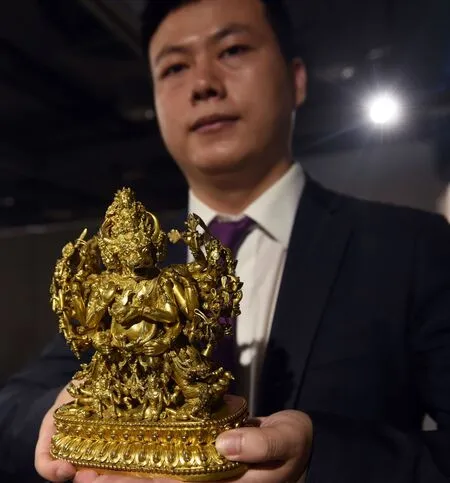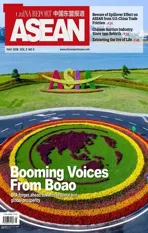Chinese Auction Industry Since 1992 Rebirth
2018-06-07ByWangFengjuan
By Wang Fengjuan
The arrival of spring heralds new beginnings across the spectrum, including international fine arts, with the commencement of auction season at firms such as Sotheby’s and Christie’s. China Guardian Hong Kong Auctions, a wholly owned subsidiary of China Guardian Auctions, completed a total sales of HK$420 million(US$53.85 million) during their Spring Auctions from April 2 to 3.Other auction houses including Poly International Auction and Beijing Hanhai Auction also began to present a steady stream of auctions.
Nearly 26 years have passed since thefirst international auction of the People’s Republic of China was held in 1992. Before that milestone event, most Chinese people on the longclosed Chinese mainland did not know much about art auctions.
First International Auction
China’s auction industry emerged in the mid-19th Century, but no auction houses continued operating on the Chinese mainland after industry transformation in 1953.
Senior industry insider Dong Yurong is quite familiar with the development of the auction industry in China. According to Dong, thefirst auction house on China’s mainland was established in Guangzhou,capital of Guangdong Province,in November 1986. The Beijing International Auction was held by Beijing Municipal Administration of Cultural Heritage in October 1992. Thefirst art auction certificate of China’s mainland was issued to Shanghai Duoyunxuan Auction House Co., Ltd. in July 1992.China Guardian Auctions Co.,Ltd. was established in 1993.
The 1992 Beijing International Auction, thefirst of its kind since China launched reform and opening-up in 1978, sparked heavy buzz since its first inception. Beijing’s municipal government even organized a lead team headed by a deputy mayor to oversee the event.
Zhang Deqin, former director of the State Administration of Cultural Heritage, has fond memories of the auction. Zhang recalls that as soon as the news was announced, it brought great repercussions at home and abroad. The admission tickets for the auction were priced at 450 yuan, 2.5 times the monthly per capita income of the urban population in the country in 1992.Beginning on October 11, the auction house was packed with more than 300 bidders from home and abroad as well as numerous domestic collectors and industry insiders for four consecutive days.Serving the auction site were more than 100 security police officers, 65 armed police and 72 interpreters of various foreign languages. More than 500 media outlets covered the event.

A bronze piece from the Ming Dynasty(1368-1644) is displayed in Hong Kong on September 5,2017.
“This form of art auction was common practice on the international stage,” explains Zhang Deqin. “But at that time,it was unprecedented for us.We believed history would look fondly on our experiment whether it succeeded or not—thefirst exploration of this form of art auction is worth recognition and commemoration.”
Since then, the auction industry in China experienced ups and downs before settling into a standardized and mature track.
Growing Pains
Qi Zhifeng, vice chairman of China Association of Auctioneers, maintains that reform and openingup promoted the prosperity of the auction industry. The prosperity of art auctions re flects improvements in living standards and spending power of the people. Consumer groups have also expanded from collectors to ordinary people.This is one of the biggest changes brought by reform and openingup to the auction industry.
During the development of China’s auction industry,its relative immaturity left it vulnerable to storms such as the 1997 Asian financial crisis,the 2003 SARS outbreak and the 2008 world financial crisis. So it has experienced evolution from turbulence to stable maturity as industry regulations, legal consciousness, and brand and marketing concepts have gradually been established. After several adjustments, the auction market has enjoyed a sustained upswing since the autumn auction of 2003, with new records set one after another.
According to incomplete statistics, in 2005, the total turnover of art auctions in China reached nearly 10 billion yuan(US$1.6 billion); the public was enthusiastic about art collection and more than 70 million art collectors were counted across the country.
The Autumn Auctions of 2009 set many records in Chinese auction history, and the season’s total contract value was 15.646 billion yuan (US$2.5 billion),thefirst time the total turnover of a single season of auctions surpassed 15 billion yuan(US$2.4 billion) since 1992.
In 2010, the auction market reached a third climax—the arrival of the “hundred-million-yuan era” with multiple items selling for more than 100 million yuan(US$15.7 million) each. Total turnover that year reached 37.2 billion yuan (US$5.9 billion), up 138 percent compared to thefigure of 2009. Many industry insiders believe that this speed of growth will be difficult to replicate any time in the near future.
Although people hold different views on the emergence of the “hundred-million-yuan era,” it has brought many rare treasures into the spotlight of the Chinese art auction market over the last more than 20 years, promoting greater public awareness of the artistic value of Chinese traditional art.
Shoulder-to-Shoulder with International Markets Over the past 20-plus years, the total turnover of art auctions in China has increased dramatically, making China a formidable art market player.Beijing has become one of the“four global art markets,” the other three being Hong Kong,New York City and London. With the opening of Chinese auction market, some international auction giants have marched into Chinese mainland market.
On April 9, 2013, Christie’s announced the big news that it became thefirst international art auction house to obtain an auction license in China to conduct business independently. Rebecca Wei,president of Christie’s Asia,remarked that now-experienced collectors in Asia are usually willing to try new things, and that Western art will arouse their interest.
The auction market in China has continued to sell items from foreign countries. China Guardian Hong Kong Auctions first introduced Western and Southeast Asian oil paintings during its Spring Auctions,and the transaction volume of multiple auction items set new records for several artists. A special auction called “Dialogue with Masters” displayed the collections of nine master artists from both the East and the West, which were well received with a turnover rate of 93 percent.
“Artwork has no borders,and the principle of auctions is openness and fairness,” Qi Zhifeng maintains. “In recent years, Chinese auctions have attracted many overseas guests,and Chinese collectors are participating more in auctions in foreign countries.
Compared to the maturity of the international auction market gained over centuries,the two decades of art auctions in China represent only the beginning.
Thefirst exploration of this form of art auction is worth recognition and commemoration.
November 1986 October 1992 July 1992 1993
Thefirst auction house on China’s mainland was established in Guangzhou, capital of Guangdong Province, in November 1986.The Beijing International Auction was held by Beijing Municipal Administration of Cultural Heritage in October 1992.Thefirst art auction certificate of China’s mainland was issued to Shanghai Duoyunxuan Auction House Co.,Ltd. in July 1992.China Guardian Auctions Co., Ltd.was established in 1993.
